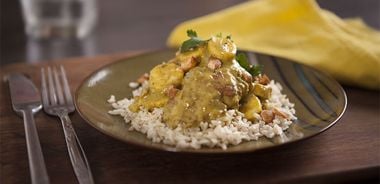Curried Chicken with Bananas

The sweet, mild flavour of bananas is a natural complement to hot, spicy curries. Once you try the combination, you will never want a banana-less curry again. Although dates work well in this recipe, raisins or other dried fruits (such as organic apricots) make a suitable substitution.
1 Tbsp (15 mL) extra-virgin olive oil
2 small onions, chopped
2 garlic cloves, minced
3/4 tsp (4 mL) grated fresh ginger
4 medium-sized boneless, skinless, organic chicken thighs
2 Tbsp (30 mL) curry powder
3 to 4 heaping Tbsp (45 to 60 mL) chopped dates (about 8 dates), soaked in 1/4 cup (60 mL) water
1 - 14 oz (400 mL) can coconut milk
Juice of 1/2 lemon
1/4 cup (60 mL) roasted, unsalted cashews
2 large ripe bananas, sliced
Heat oil in large frying pan over medium heat. Add onions and sauté, stirring frequently, until they become translucent. Add garlic and ginger to pan and sauté for another 2 minutes.
Push onion mixture to one side of frying pan and add chicken thighs. Brown chicken nicely on both sides. Add curry powder and stir well to incorporate curry into onions and chicken thighs.
Add chopped dates, their soaking water, and coconut milk. Bring mixture to a boil; reduce heat and simmer for 5 minutes with a lid covering the pan. Remove lid, and simmer mixture for another 5 minutes.
Stir in lemon juice and roasted cashews and simmer for 2 minutes more. Gently place sliced bananas into mixture and simmer for 1 minute more. Serve mixture hot over basmati rice.
Makes 4 servings.
Each serving contains: 449 calories; 12 g protein; 31 g total fat (20 g sat. fat, 0 g trans fat); 38 g total carbohydrates (19 g sugars, 5 g fibre); 54 mg sodium
source: "Go Bananas", alive #376, February 2014




